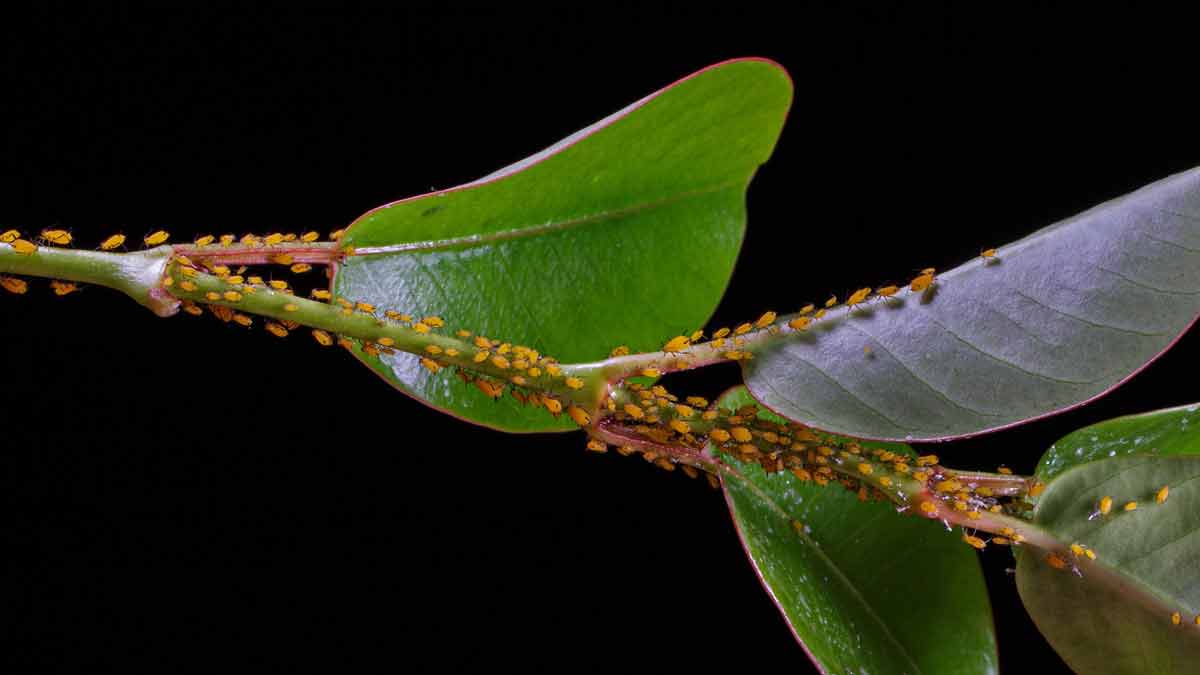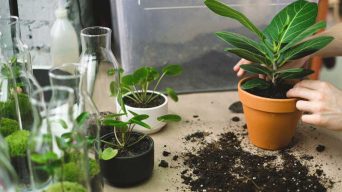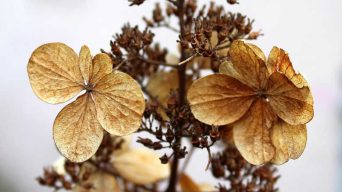To use diatomaceous earth on potted houseplants, sprinkle the powder on top of the soil when it’s dry but before the plant needs watering. It can also be mixed with water and sprayed on plants. Let it sit for about 7 days to get rid of pests. DE is safe to use directly on plants and improves drainage.
Houseplant enthusiasts know that pesky pests can quickly ruin their beloved green companions.
Diatomaceous earth is an organic and safe solution to keep those unwelcome visitors at bay.
In this easy guide, we’ll explore the benefits of using diatomaceous earth on houseplants and share step-by-step instructions for applying it effectively.
Say goodbye to insects and hello to healthy, thriving plants by reading on!
Understanding Diatomaceous Earth For Houseplants
Houseplant enthusiasts use diatomaceous earth, an organic sedimentary rock powder, to kill and repel a range of pests such as fungus gnats, mites, ants, aphids, and flies.
What Is Diatomaceous Earth?
Diatomaceous earth, often referred to as DE, is a natural sedimentary rock powder made up of fossilized remains of diatoms – tiny aquatic organisms with hard shells composed mostly of silica.
Over time, the accumulation of these diatom skeletons creates deposits that are mined and ground into an extremely fine powder with microscopic razor-sharp edges.
Diatomaceous earth has many applications in various industries, such as agriculture, food processing, filtration systems, pest control, and more.
In the context of houseplants and indoor gardening, diatomaceous earth serves primarily as a natural insecticide due to its unique physical properties.
The abrasive nature and sharp edges of the particles cause damage to the protective exoskeletons of insects like mites, aphids, ants, and flies upon contact.
This process leads to dehydration and death for these pests without using harmful chemicals or synthetic products that may pose risks for children and pets in your home environment.
Diatomaceous earth can also be used as a soil amendment to improve drainage and overall soil health for optimal plant growth.
Types Of Diatomaceous Earth
Diatomaceous earth is available in two main types, food-grade, and filter-grade.
- Food-grade diatomaceous earth is safe for use around children and pets. It is used for human consumption and as a supplement for livestock.
- Filter-grade diatomaceous earth contains higher levels of silica. It should not be used on houseplants or consumed by humans or animals.
It is essential only to use food-grade diatomaceous earth when applying it to houseplants for pest control.
Ensure that the packaging indicates that it is safe for use around pets and children before purchasing it.
Benefits Of Diatomaceous Earth For Houseplants
Using diatomaceous earth on houseplants has numerous benefits.
One of the most notable advantages is that it is a natural and non-toxic way to control pests.
Unlike chemical insecticides, diatomaceous earth does not harm beneficial insects such as ladybugs or bees.
It also does not leave behind residues that could harm humans or pets.
Additionally, diatomaceous earth can improve soil health by providing plant-available silica and other trace minerals.
This helps strengthen plants’ cell walls and boost their immune systems, leading to healthier growth and improved resistance to pests and diseases.
Another benefit of using diatomaceous earth on houseplants is its ability to absorb excess moisture from the soil.
This can help prevent fungal infections like root rot or mildew, especially in humid environments where moisture buildup can quickly become problematic.
Incorporating diatomaceous earth into your houseplant care routine can benefit your plants’ health and pest control needs.
How To Use Diatomaceous Earth On Houseplants
To use diatomaceous earth on houseplants, sprinkle it on top of the soil or mix it with potting soil to repel pests and improve your indoor plant health. Alternatively, mix food-grade diatomaceous earth with water and spray it directly onto the leaves for insect control.
Sprinkling On Top Of Soil
Sprinkling diatomaceous earth on top of the soil is a simple and effective way to keep pests at bay in houseplants.
To apply, sprinkle the powder over the soil’s surface around your plants.
The sharp edges of the microscopic diatoms that make up diatomaceous earth work to dehydrate and kill many pest insects upon contact.
One key advantage of this method is that it’s easy to target hard-to-reach areas around leaves or plant stems where bugs congregate.
It’s important to note, however, that sprinkling too much DE can lead to oversaturation, which may suffocate roots and cause damage over time.
Use enough DE powder for visible cover with a salt shaker or similar tool.
Remember, while DE is an organic product safe for humans and pets when used correctly, it’s essential always follow safety precautions such as wearing protective gear like gloves and masks when applying it.
Mixing With Potting Mix
Mixing diatomaceous earth with potting mix is a great way to prevent pests from attacking your houseplants at the roots.
Add one or two tablespoons of food-grade diatomaceous earth per gallon of potting soil before planting your plants.
This will create an inhospitable environment for insects and other pests by creating microscopic barbs that perforate and dehydrate their exoskeletons.
It’s important to note that while mixing diatomaceous earth with potting mix helps prevent pest infestations, it doesn’t provide any nutritional benefits to your plants.
So if you’re also looking to improve plant health, consider adding compost or other organic fertilizers along with the diatomaceous earth.
Using food-grade diatomaceous earth with potting soil effectively keeps indoor gardens happy and healthy without resorting to toxic chemical pesticides.
It’s also affordable and easy to find – just be sure you’re buying food-grade quality so you can trust that it’s safe for your pets, children, and plants.
Spraying With Water
Another way to apply diatomaceous earth on houseplants is by spraying it with water.
This method works particularly well for plants with hard-to-reach areas or leaves covered in pests.
To do this, mix food-grade diatomaceous earth with water until it forms a smooth paste and pour it into a spray bottle.
When ready to use the spray, shake the bottle well to fully blend the mixture, and then mist the affected parts of your houseplant.
Make sure to coat both sides of each leaf thoroughly without leaving any area untouched.
The mixture dries quickly and creates a white powdery layer on your plants, which will kill off insects when they come into contact with it.
Reapply after rainfall or watering since moisture can wash away some of its effectiveness.
Using this method regularly will eliminate pests while promoting plant health in no time!
Safety Precautions When Using Diatomaceous Earth On Houseplants
When using diatomaceous earth on houseplants, it is important to take safety precautions such as wearing protective gear, applying the powder correctly, and avoiding inhalation to prevent any harm to yourself or your plants.
Protective Gear
When using diatomaceous earth on houseplants, it is essential to take precautions to protect yourself from potential irritants or inhalation.
Here are some protective gear and measures you can take:
- Wear gloves to prevent any skin irritation or dryness.
- Use goggles or a face mask when applying diatomaceous earth to avoid the inhalation of the fine powder.
- Apply the powder in a well-ventilated area to prevent dust buildup and minimize inhalation.
- Wash your hands and face thoroughly after applying diatomaceous earth to remove any residue.
These simple measures allow you to safely and effectively use diatomaceous earth on your houseplants without worrying about adverse reactions.
Remember that while diatomaceous earth is safe for humans and pets, handling the substance cautiously for the best pest control results is still important.
Proper Application Techniques
To ensure that diatomaceous earth is applied safely and effectively to houseplants, here are some proper application techniques:
- Apply the powder in a dry form to maximize its effectiveness in killing pests. Wetting it down first will reduce its potency.
- Sprinkle the powder on top of the soil or mix it evenly into the potting soil before planting.
- Use a salt shaker or similar container with small holes to help distribute the powder evenly across the soil’s surface.
- If using food-grade diatomaceous earth mixed with water as an insecticide, shake it well before spraying and avoid spraying directly onto leaves.
- Reapply the powder after rain or watering to maintain its effectiveness in controlling pests.
- Avoid applying too much powder, which can clog up air vents on potted plants and impact their growth.
- Focus on hard-to-reach areas where pests tend to congregate, such as under leaves or along stems.
These application techniques ensure that diatomaceous earth is used safely and effectively to keep your houseplants healthy and pest-free.
Avoiding Inhalation
Taking precautions when using diatomaceous earth on houseplants is vital to avoid inhalation.
Fine dust particles can irritate the eyes, nose, and throat if inhaled.
To prevent this, it is recommended that you wear a protective mask while applying diatomaceous earth.
When sprinkling the DE powder onto your plants, make sure not to create too much dust by doing it slowly and gently.
You may also want to keep children and pets away from the area until after the application.
Another way to avoid inhalation is by applying diatomaceous earth with a spray bottle filled with water instead of dry powder.
This method will reduce dust and help the product stick more effectively on leaves for better pest control.
By taking these simple steps, you can safely use diatomaceous earth on your houseplants without any harm caused by inhaling its fine particles.
Remember to prioritize safety when dealing with any gardening products or chemicals at home.
Common Questions About Using Diatomaceous Earth On Houseplants
Frequency Of Application
When it comes to using diatomaceous earth on houseplants, the frequency of application will depend on the severity of the pest problem.
If you’re dealing with a heavy infestation, you may need to apply diatomaceous earth once a week until the houseplant pests are under control.
However, if you’re using it as a preventative measure or for maintenance purposes, you can apply it every two to four weeks.
It’s worth noting that diatomaceous earth is only effective when the plant is dry. Hence, it’s important to reapply after rain or watering your plants.
Additionally, if you notice new insect activity on your houseplants, don’t hesitate to reapply diatomaceous earth as needed.
Overall, consistency is key when using diatomaceous earth on houseplants.
Applying it regularly and monitoring your plants for signs of pests can keep them healthy and thriving without resorting to harsh chemicals or pesticides.
Compatibility With Different Types Of Houseplants
Diatomaceous earth is compatible with a wide range of houseplants.
It can be used on flowering plants, succulents, herbs, vegetables, and more.
However, it’s important to note that some plants may react differently to diatomaceous earth than others.
For example, it has been reported that sensitive ferns and some orchid species may show signs of leaf burn or other damage when treated with diatomaceous earth powder.
Before using diatomaceous earth on your houseplants, check their requirements and care instructions.
Some plants may require less frequent application than others or need different application techniques.
Additionally, if you have edible plants in your indoor garden, use food-grade diatomaceous earth for safety.
Overall, compatibility should not be a significant concern when using this natural pest control method on your beloved houseplants as long as proper research is conducted before applying it.
Just keep in mind the unique characteristics of each plant species and adjust accordingly for optimal results.
Effect On Beneficial Insects
Diatomaceous earth is known for controlling various pests, such as:
- Springtails
- Fungus gnats
- Millipedes
- Spider mites
- Ants
- Aphids
However, you might wonder how it affects beneficial insects like ladybugs and bees.
The good news is that diatomaceous earth only targets soft-bodied insects and leaves the helpful ones unharmed.
Beneficial insects play an essential role in maintaining healthy plant growth by pollinating flowers and feeding on harmful pests.
When using diatomaceous earth on your houseplants, rest assured that it won’t negatively affect these garden helpers.
In fact, by eliminating harmful pests from your indoor garden with diatomaceous earth, you may attract more beneficial insects to your plants.
As with any pest control method, it’s important to use diatomaceous earth in moderation to not upset the delicate balance of your indoor ecosystem.
Be mindful of the frequency of application and ensure to use it sparingly if you want to maintain a healthy environment for your plants and their beneficial insect allies.
Final Thoughts
Diatomaceous earth is a fantastic natural solution for keeping your houseplants pest-free and healthy.
By sprinkling it on top of the houseplant soil or mixing it into potting mix, you can protect your plants from spider mites, ants, aphids, fungus gnats, and flies without having to resort to harmful chemicals.
Additionally, using food-grade diatomaceous earth mixed with water as an insecticide spray effectively controls pests in hard-to-reach areas.
Just be cautious when handling the powder and wear protective gear while applying it.
With its cost-effectiveness and ease of use, diatomaceous earth should be a staple in any indoor gardener’s toolkit!







